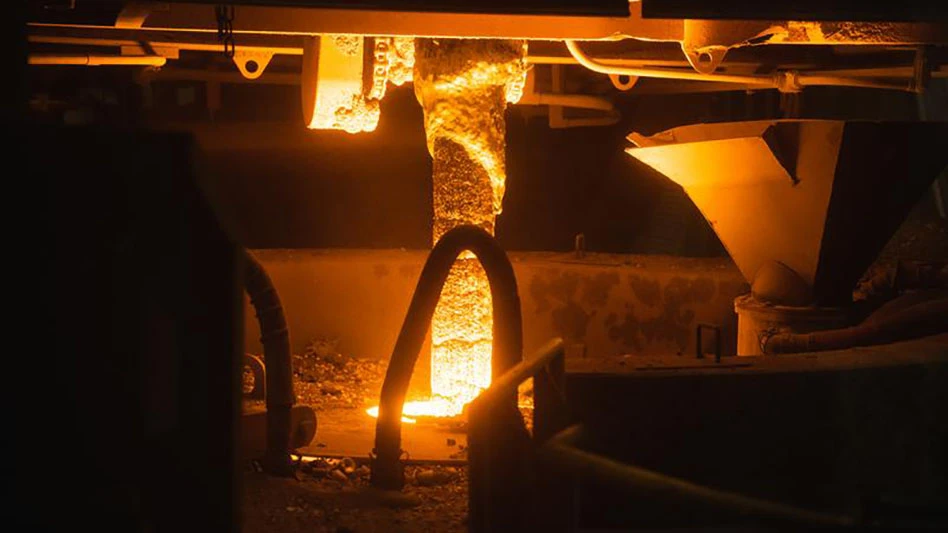The new rules are intended as a deterrent to childhood lead poisoning, and are inspired by Article 10 from the 1992 Community Development Act. The intention ultimately is to lower the cost of lead abatement projects by allowing disposal of waste in C&D landfills. The proposed rule outlines LBP management and handling procedures, defining any trace of LBP as hazardous and setting disposal options—none of which involves recycling.
What the EPA sees as a health issue on one hand also presents a solid waste handling and recycling issue on the other.
Some are saying the EPA’s no-tolerance tactic in handling LBP debris will be fatal to the C&D recycling industry. Others say it adds definition to a broad-based, wishy-washy issue—a guideline, a liability saver, a safety net. The EPA collected more than 250 comment letters during an extended period of gathering input from industry members and the public, and though this period is over, the waiting game has apparently just begun.
CONCERN FOR CONSEQUENCES
There are several issues to hammer out before the proposal is finalized, and some C&D recyclers feel their jobs depend on it. Richard McCandless, a recycling and marketing manager for Kroeker, Inc. in Fresno, Calif., is one of them, and is dedicated to using all his resources to prevent the passage of the proposal as it is currently written.
“There is some good philosophy that goes into the proposal—we need to protect our children and our people and our environment. I would like to see a partnering arrangement between the EPA and the industry people,” McCandless comments.
McCandless attended one of two national meetings arranged by the EPA to discuss and present the proposal in January. Notified only days before the meeting, he found the lack of publicity discouraging—only 700 fliers were distributed advertising the event throughout the nation, he says, doing some quick math to come up with an average of 14 fliers for each state. The day after the meeting, McCandless got to work. He composed and sent out letters to industry members, congressmen and the media, shocked at the rigidity of the proposal, he says.
“At first response, I don’t think people took alarm—they didn’t realize the severity of the proposal. They thought, ‘they can’t just do that,’” he comments. “Well, yes they can.”
He believes the C&D recycling industry, and its waste wood recycling component, will be casualties if the proposal is passed as is. With a vast industry relying on recycled concrete as roadbed and a nascent wood waste recycling industry now beginning to grow, the proposal will squelch these environmental advancements, he says.
“The consumer is going to pay,” he predicts, assuming price increases will be spurred by rising landfill costs, transportation costs and tipping fees. “This is a very, very dramatic action that’s taken place by the EPA. I believe sincerely, with all my heart, there was no consideration given to the economics of this proposal.”
SIFTING THROUGH STATISTICS
The EPA, for its part, says it did not walk blindly through the policy-making procedure.
They conducted in-depth exploration of the interests of high stakes holders, according to Tim Lehman, who developed the economic analysis portion of the proposal. Groups like the National Association for Demolition Contractors (NADC), Doylestown, Pa., and the Materials for the Future Foundation, San Francisco, were solicited for input regarding possible impacts on industries.
Lehman says the economic analysis conducted prior to the release of the proposal covered the appropriate bases and gave the agency accurate feedback to work with in writing the rule. The question may be how bountiful and how specific was the information that surfaced during preliminary investigations.
“I think they made a good faith effort,” says Michael Taylor, executive director of NADC. “There just wasn’t that much out there for them to hang their hats on.”
The EPA is still seeking information. In the proposal itself they request any research or scientific data to solidify input, and remain open to any updated studies regarding lead-based paint debris disposal.
“I personally believe that the EPA handled it very well,” Taylor adds. “They asked for a lot of input, they came up with things. Many elements of the rule the demolition industry agrees with, but we have concerns. It could have a serious impact on the C&D industry in many parts of this country.”
Mark Henshall, Chief of the Lead, Metals and Inorganics branch of the U.S. EPA, says this is an impact they did not foresee.
“The comments are legitimate concerns, that it will have an impact we did not intend,” he comments. “We will be looking into it a lot more closely.”
Gathering Concrete Evidence
Some concerns uncovered in NADC’s comment letter to the agency include the definition of lead-based paint debris and the disposal options for the material. As written, LBP demolition debris is any solid material which results from the demolition of target housing, public buildings or commercial buildings which are coated wholly or in part with or adhered to by lead-based paint at the time of demolition.
This includes concrete—a problem for many in C&D recycling.
“We were very aggressive in our suggesting that this is not the way to go and we are hopeful that they don’t include concrete with LBP in their final definition of non-recyclable debris,” Taylor says.
With 104 million tons of concrete reused in the U.S. in 1997—totaling more than three quarters of recycled construction and demolition debris—requiring disposal of this material would undoubtedly impact the growing concrete recycling industry, the NADC’s letter states.
And the NADC is not the only constituency uneasy about the effects of making concrete more difficult to recycle. Quite a few members of the industry also voiced their concern. When it is buried underneath asphalt, potentially hazardous debris is not exposed and does not cause harm to human health, Taylor says. It could, however, cause road repairs and additions to be more cumbersome and expensive if passed, some industry members say. Many states rely on this material for these purposes.
“The volume of material that is being recycled every year is increasing,” Taylor says. “It’s a huge industry. Painted concrete is a very small proportion of the material—the volume of lead in that massive 100 million tons of material is so small, do you really want to attempt to regulate this? What’s the reuse? To bury it under the asphalt.”
William Turley, executive director of the Construction Materials Recycling Association, Lisle, Ill., does not consider concrete a stopping point in negotiations. He believes most of the materials can be eliminated from the rule because of the industry’s safe practices.
“Lead has been a concern of state regulators for a long time, but many processors within the industry long ago have learned how to handle it or how to dispose of it,” he says. “It’s always been there. It’s always been handled properly. Processors who knew how to handle it knew what to do with it, and those who didn’t landfilled it.”
The gray area emerges when identifying acceptable recyclable material. In the past, the industry relied on a toxicity characteristic leaching procedure (TCLP). Critics call it an unreliable and costly test that proved to be an inconsistent determination of whether or not material contained hazardous amounts of lead-based paint. The de minimus rule, where a lead concentration of less than 0.5 percent and a limited access environment is considered non-hazardous, is the regulation McCandless follows as mandated by the California Department of Health Services.
The EPA’s proposed rule requires all material with traces of lead-based paint be disposed in C&D landfills. No gray area, no minimum toxicity, no questions asked.
“My impression is that as far as deconstruction goes, the proposed rule will have a negligible impact on the industry,” says Lisa Geller, a program coordinator for the Materials for the Future Foundation who was consulted during the drawing of the proposal. “The regulatory environment is currently fairly vague, so a lot of folks in deconstruction won’t take buildings if they think they’ll have large amounts of LBP debris, because currently it’s not clear to what standard they’re held to to dispose of that debris.”
While this might mean a cut and dry process of determining what can be reused, some see it as a cut to their business. The only exception to disposing of the LBP debris is abating it—completely stripping and removing all paint according to EPA guidelines.
BUSINESS AS USUAL?
With recycling technology advancing on a daily basis, some in the industry are wondering if they will be able to take advantage of the progress. They are also wondering if this proposal will put a damper on recycling goals, like California’s mandate to divert 50% of landfill waste by the year 2000.
“We’ve spent over $1.5 million out of our pocket to get where we are now,” McCandless says. “We qualified for a loan through California State Integrated Waste Management to help us develop our recycling center, and if this bill is passed, it puts our recycling business out of business.”
The reuse industry, where parts of buildings are recovered and resold, may also experience this feeling, as much of their inventory becomes “hazardous,” and is sent to landfills.
Some are predicting a makeover to the current proposal while some hope for refinements.
“The scenario exists where common sense will rule and the EPA will remove some of this material—other material besides concrete—from this proposal,” CMRA’s Turley says. “The rule overreaches.”
The NADC’s Taylor is also interested to “see what the next round brings,” as it may have significant impact on the C&D recycling industry. And like many, he will be following the progress as the EPA consolidates information and makes a decision.
Regardless, the process will take time and research.
McCandless remarks that the only preparations to make are to begin selling off equipment. Even then, if recycling is not a viable option the equipment, too, may hold little value.
“Right now, it’s a waiting game,” he says. RT
Scott Morris, senior project manager for J.I. Garcia Constructions in Fresno, Calif., considers this proposal a springboard for further development in the industry. Long term effects of LBP hazards are important, he says, and the primary people who will be effected by this rule are those who deal with large quantities of the substance. Small players may not feel the weight of this proposal.
And though dealing with LBP debris may be costly at first, it will be a matter of time before the industry adjusts, he says. Morris is already exploring a grinding process to reduce waste that avoids lead emissions.
“It’s going to be an expensive process, but so were VCRs when they first came out,” he comments. “It’s a matter of reducing the volume of waste—that’s what we have to work on. That’s the avenue that needs to be taken.”
Reaching the Rule
Meanwhile, comment letters are being considered and research is being solicited. The EPA continues to sort, organize and summarize the letters, with content varying from one page to much longer documents, Spector says. The final rule will be released in the fall of 2000, with a two-year grace period before implementation.
Some are predicting a makeover to the current proposal while some hope for refinements.
“The scenario exists where common sense will rule and the EPA will remove some of this material—other material besides concrete—from this proposal,” Turley says. “The rule overreaches.”
Modifications to the rule are necessary, adds Geller, but the importance of recognizing the dangers of lead must not be ignored.
“My bottom line is that there are aspects of the rule that need to be refined, but the point of the rule is to reduce the amount of lead that is in the residential environment,” she says. “I think it’s extremely important that we look for a way to balance the human health industries and encourage the growth of the deconstruction industry.”
Taylor is also interested to “see what the next round brings,” as it may have significant impact on the C&D recycling industry. And like many, he will be following the progress as the EPA consolidates information and makes a decision.
Regardless, the process will take time and research.
McCandless remarks that the only preparations to make are to begin selling off equipment. Even then, if recycling is not a viable option the equipment, too, may hold little value.
“Right now, it’s a waiting game,” he says.
WHAT IT ALL MEANS
Who does the proposed rule affect?
• Individuals and firms who generate and/or store LBP debris.
• Waste transporters • Re-users of LBP debris
• Reclamation facility owner/operators
• Disposal facility owner/ operators
The rule defines LBP demolition debris as all materials that result from demolition of target housing, public buildings or commercial buildings which are coated wholly or in part with or adhered to by LBP at the time of demolition.
• This includes all demolition debris from buildings built before 1978
Disposal/reclamation options:
• Construction and demolition landfills
• Non-municipal landfills which accept conditionally exempt small quantity generated waste
• Hazardous waste disposal facilities, including hazardous waste incinerators and landfills
• In the case of incineration, facilities subject to specified Clean Air Act requirements
Current or plausible health risks considered by the proposed rule:
• Application of LBP debris as mulch or wood chips or use of LBP debris as ground cover or for any landscaping purpose
• Compacting or burying LBP debris for use as fill material, roadbed material, or for site leveling purposes
• Reuse of LBP debris which has deteriorated paint
• Reclamation through burning of LBP debris in facilities without controls on lead emissions
• Transporting LBP debris in uncovered vehicles
• Storage of LBP debris without access limitation
The EPA says they are unaware of data on the prevalence and methods associated with application of LBP debris as landscape material, roadbed material or fill material…
The Agency requests data and further information on these practices and encourages public comment on how these activities should be regulated in the final rule.
• LBP Debris is no longer under RCRA requirements
A copy of the proposed rule if available online at
http://www.epa.gov/homepage/fedrgstr/
Information from the Federal Register/Vol.63, No. 243/Friday, December 18, 1998/Proposed Rules; Management and Disposal of Lead-Based Paint Debris

Explore the September 1999 Issue
Check out more from this issue and find your next story to read.
Latest from Recycling Today
- AF&PA releases 2023 paper recycling rate, unveils new methodology
- ARA names new president
- Aurubis invests in Lünen, Germany, site
- ILA, USMX negotiations break down
- Van Dyk hires plastics industry vet to expand footprint in PRF sector
- Li-Cycle closes $475M loan with DOE
- Report highlights consumer knowledge gaps in lithium battery recycling
- AMP names CEO





